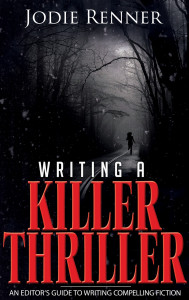Today I welcome back to TKZ my friend and editor, Jodie Renner, to share her checklist on adding suspense and intrigue to your story. Enjoy!
on adding suspense and intrigue to your story. Enjoy!
Jodie Renner, editor, writer, speaker
We all know that thrillers and other fast-paced popular fiction need lots of tension, suspense, and intrigue. But so does any other compelling story that’ll create a buzz and take off in sales. No matter what genre you write, it’s all about hooking your readers in, engaging them emotionally, and ensuring they keep eagerly turning the pages.
Here’s a handy checklist for ratcheting up the tension and suspense of your novel or short story. Use as many of these elements and devices as possible to increase the “wow” factor of your fiction.
Plan and set up a riveting story:
__ Give readers a sympathetic, charismatic, but flawed protagonist they’ll identify with and start worrying about.
__ Create a nasty, cunning, believable villain (or other antagonist) to instill fear and anxiety.
__ Devise a significant, meaningful story problem, a serious dilemma for your hero, preferably a threat with far-reaching consequences.
__ Make it personal to your protagonist. She and/or her loved ones are personally threatened.
Bring your protagonist and story to life on the page.
__ Use close point of view (deep POV) and stay in the head of your protagonist most of the time, for maximum reader engagement.
__ Show your main character’s reactions to people and events around him.
__ Evoke all five senses – what is she seeing, hearing, smelling, touching, and tasting?
__ Show his inner fears, anxieties, anger and frustrations.
__ Use occasional brief flashbacks in real time to reveal her secrets and fears, deepen characterization, and strengthen reader involvement.
__ Use alternating viewpoints – put us in the head of your protagonist and antagonist (or, in a romantic suspense, the female and male leads).Give them each their own scenes or chapters, so readers find out what the antagonist is thinking and planning, too. But stay mostly in your protagonist’s POV, to keep us bonded with her.
Pile on the problems:
__ Keep raising the stakes for your protagonist. Just as he solves one problem, he’s confronted with an even worse obstacle or dilemma.
__ Hamper your hero or heroine at every turn – the gun is jammed or falls into the river, the door is locked, the cell phone battery is dead, the car runs out of gas, there’s a roadblock ahead, …
__ Give her tough choices and moral dilemmas. The right decision is the most difficult one; the morally wrong choice is the easy way out.
Set the tone with style, mood, and pacing:
__ Show, don’t tell. Don’t intrude as the author, and minimize explanations and backstory.
__ Write tight. Make every word count.
__ Vary your sentence structure to suit the situation and mood.
__ Use distinctive, vivid verbs and nouns rather than overused, generic ones, like “walked” or “ran.”
__ Use strong imagery and just the right word choices to set the mood.
__ Vary the pacing and tension level. Nonstop action can be exhausting.
Pay attention to chapter and scene structure:
__ Don’t spend a lot of time on lead-up or wind-down. Start chapters late and end them early.
__ Make sure every scene has some conflict and a change.
__ Use cliffhangers frequently at the end of chapters – but not always.
__ Employ some jump cuts – end a chapter suddenly, without resolving the issue, then start the next chapter with different characters in a different scene.
__ Show all critical scenes in real time, with tension, action, reactions, and dialogue.
__ Skip past or quickly summarize transitions and unimportant scenes.
Experiment with these devices to increase suspense and intrigue:
__ Sprinkle in some foreshadowing – drop subtle advance hints and innuendos about critical plot points or events.
__ Withhold information – use delay tactics, interruptions at critical points.
__ Stretch out critical scenes – milk them for all they’re worth.
Surprise or shock your readers:
__ Add in a few unexpected twists. Put a big one in the middle and another big one at the end.
__ Use surprise revelations from time to time – reveal character secrets and other critical information the reader has been dying to know.
__ Have your main character experience at least one epiphany – a sudden significant realization that changes everything for them. Try putting one in the middle and one near the end.
__ Write in some reversals of feelings, attitudes, expectations, and outcomes.
Keep adding more tension. Increase the troubles of your protagonist by using these plot devices:
__ Ticking clocks – every second counts.
__ Obstacles, hindrances – keep challenging your hero or heroine.
__ Chases – your protagonist is chasing or being chased.
__ Threats or hints of more possible danger ahead.
__ Traps and restrictions – your character becomes somehow trapped and must use all their resources to get out of the situation.
Create a memorable, satisfying ending.
 __ Design a big showdown scene, an extremely close battle between the hero/heroine and the villain.
__ Design a big showdown scene, an extremely close battle between the hero/heroine and the villain.
__ Write in a surprise twist at the end.
__ Leave your readers satisfied – the hero wins by a hair, the main story question/conflict is resolved.
Jodie Renner is a freelance fiction editor and the award-winning author of three craft-of-writing guides in her series An Editor’s Guide to Writing Compelling Fiction: Captivate Your Readers, Fire up Your Fiction, and Writing a Killer Thriller. She has also published two clickable time-saving e-resources to date: Quick Clicks: Spelling List and Quick Clicks: Word Usage. You can find Jodie at www.JodieRenner.com, www.JodieRennerEditing.com, http://jodierennerediting.blogspot.com/ and on Facebook, Twitter, and Google+.

This Checklist is great!
I will review it at the beginning of every writing session, and quite possibly some of it will sink in.
Great list, Jodie!
Under Adding more tension: More bodies, especially if they are bodies of the MC’s allies. 🙂
Kathy
Thanks for your comments, Dave and K.S.
Just want to let everyone know that I was going to change the title for my updated, expanded WRITING A KILLER THRILLER, but decided to stick with the same title: Writing a Killer Thriller – An Editor’s Guide to Writing Compelling Fiction. The link for the new edition is: http://www.amazon.com/Writing-Killer-Thriller-Compelling-ebook/dp/B00DANRNLS/. I know Joe is busy moving today, so maybe someone from TKZ could go in and change the subtitle and add this link? Thanks a lot!
Also, I want to thank Joe Moore for inviting me back to guest post on this awesome blog, and wish him well on his big move! Good luck with everything, Joe! Hope you get settled in quickly so you can find everything and get back to writing!
Add to the list?
The only thing I could add would be:
_ READ JODIE’S LIST!
Thanks, Basil! Glad you find my checklist helpful!
These are wonderful guidelines for adding suspense to a story. Sometimes I’ll use isolation–isolate the hero or heroine and then deploy bait and switch tactics, leaving one character in jeopardy before switching to the other viewpoint and back again.
Those are excellent ideas, Nancy – thanks! The isolation one is a great one that I didn’t think of. I wrote about the bait and switch one in my revised, updated Killer Thriller book. I didn’t have the new link yet when Joe posted this, but it’s http://www.amazon.com/Writing-Killer-Thriller-Compelling-ebook/dp/B00DANRNLS/
Jodie –
Quite the comprehensive list!
I don’t know that it warrants addition to the list but I think that envisioning setting cinematically can be of benefit. Brief description of the significant elements of setting can enhance/impact mood, tension and emotion.
I recently purchased an electronic copy of your ‘Killer Thriller'(laid out a whole $1.99 !) and got a better view of the cover (image is at end of blog contribution above). The image is an example of a setting that communicates.
Disclosure to TKZers: Jodie is my editor and I share Joe’s appreciation of her skills. I guarantee that the book is a winner.
Thanks, Tom, for both your excellent suggestion re setting and your kind endorsement of my book and my editing skills! I loved working on your awesome thriller and can’t wait to see it out in print!
Great advice, Jodie! I’ll keep these handy for the next rewrite. One thing though, with my new thriller, the story isn’t that personal to the protagonist because she’s an FBI agent on assignment. That’s often the case with realistic law enforcement stories.
Thanks, LJ. I’ve seen thriller writers find ways to threaten the law enforcement protagonist somehow, or someone close to them. Doing that really adds to our worry about them, so makes us more emotionally engaged.